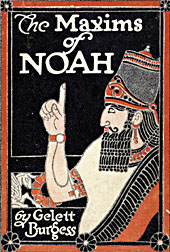
|
The special event, which includes a reception, will take place 5-7 p.m. on Wednesday, Sept. 25, at the Beinecke Library, corner of Wall and High streets.
"Gleaming Gold, Shining Silver" invites visitors to walk back 100 years in time and experience what a popular book store might have had for sale around the turn of the century.
The exhibit gathers over 200 books that were meant to attract readers by the beauty or boldness of their covers, which are decorated in gold and silver and imprinted with lively illustrations. These volumes, most of them bound in cloth, feature images ranging from symmetrical Victorian floral decorations to art nouveau and poster-style designs.
Prepared by designer and book historian Sue Allen, "Gleaming Gold, Shining Silver" was drawn from a collection of more than 800 volumes acquired by the library earlier this year and originally amassed by the sculptor and graphic artist Leonard Baskin and his wife, Lisa Unger Baskin.
The exhibit traces the development of cloth bindings from the 1850s through the first decade of the 20th century, chiefly in the United States. It explores how the interplay of marketing strategies, advancing technology and the dictates of popular fashion led to a proliferation of varied cover styles.
The use of cloth to cover books began in the mid-19th century shortly after the production of cloth became industrialized. Realizing that the cover could be used as a marketing device, book manufacturers began to adorn their books with symmetrical, non-specific patterns -- such as garlands, urns and stylized floral patterns -- to make them suitable for display in an elegant parlor. The exhibition includes examples of various 19th-century book cloths, a specimen of gold leaf and a selection of brass stamps like those used to produce these early covers.
Later, stamping in black and white became common, and by the 1880s the look of silver stamping was achieved with a mixture of palladium and aluminum, which was not subject to tarnish the way real silver would be. Several books illustrate each of these developments.
Most of the books in the display, how-
,ever, come from the period 1890 to 1910, when the art of cover design flourished. During these decades, the use of photoengraving made it easier to translate the artist's work directly to cover design; new materials and techniques came into play; and styles proliferated.
The era of the illustrated cover came to an end in the early 20th century with the advent of the dust jacket. Book manufacturers saw that the jacket, which was easier and cheaper to print than a cloth cover, could serve just as well as a marketing device. The exhibition includes a handful of transitional volumes -- books with decorated covers and jackets imprinted with the same design or its outline.
This exhibition, which continues through Oct. 12, is open to the public free of charge during regular library hours, Monday-Friday, 8:30 a.m.-5 p.m. and Saturday, 10 a.m.-5 p.m.
T H I S
Bulletin Home
 W E E K ' S
W E E K ' S S T O R I E S
S T O R I E S![]()
 NSF funds study to curb crop losses
NSF funds study to curb crop losses
![]()
![]()
 Campus marks anniversary of Sept. 11 terrorist attacks
Campus marks anniversary of Sept. 11 terrorist attacks![]()
![]()
 Sept. 21 is 'Yale Employee Day at the Bowl'
Sept. 21 is 'Yale Employee Day at the Bowl'
![]()
![]()
 Slavery's impact on Yale and New Haven to be explored
Slavery's impact on Yale and New Haven to be explored![]()
![]()
 Corporation names new senior fellow
Corporation names new senior fellow![]()
![]()
 ENDOWED PROFESSORSHIPS
ENDOWED PROFESSORSHIPS![]()
 In new programs, school partners with local health centers . . .
In new programs, school partners with local health centers . . .![]()
![]()
 Exhibit explores Romantic artists' interest in the natural world
Exhibit explores Romantic artists' interest in the natural world![]()
![]()
 Library displays book covers in 'Gleaming Gold, Shining Silver'
Library displays book covers in 'Gleaming Gold, Shining Silver'![]()
![]()
 Newer antipsychotic medication helps curb some of the behavioral problems . . .
Newer antipsychotic medication helps curb some of the behavioral problems . . .![]()
![]()
 Noted Taliban expert and journalist will speak on campus
Noted Taliban expert and journalist will speak on campus![]()
![]()
 SOM Dean to kick off campus United Way campaign
SOM Dean to kick off campus United Way campaign![]()
![]()
 Forum will boost public knowledge about forest certification . . .
Forum will boost public knowledge about forest certification . . .![]()
![]()
 Event celebrates Cuban literature
Event celebrates Cuban literature![]()
![]()
 Images from the Sept. 11 commemoration activities on campus
Images from the Sept. 11 commemoration activities on campus![]()
![]()
 Library appoints four new senior department heads
Library appoints four new senior department heads![]()
![]()
 Yale senior picked as one of Glamour's top 10
Yale senior picked as one of Glamour's top 10![]()
![]()
 Back near Broadway
Back near Broadway![]()
 |
| Visiting on Campus
Visiting on Campus |
| Calendar of Events
Calendar of Events |
| In the News
In the News |
| Bulletin Board
Bulletin Board![]()
Yale Scoreboard |
| Classified Ads
Classified Ads |
| Search Archives
Search Archives |
| Deadlines
Deadlines![]()
Bulletin Staff |
| Public Affairs Home
Public Affairs Home |
| News Releases
News Releases |
| E-Mail Us
E-Mail Us |
| Yale Home Page
Yale Home Page